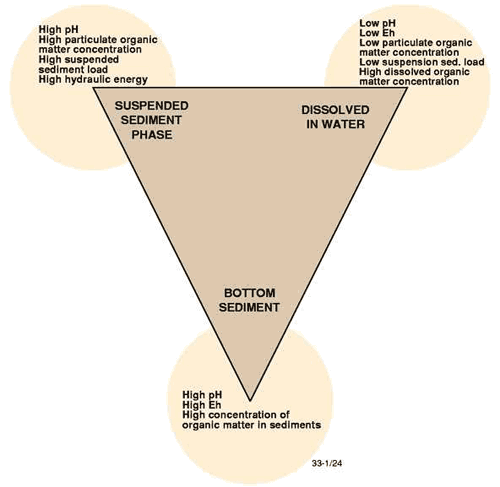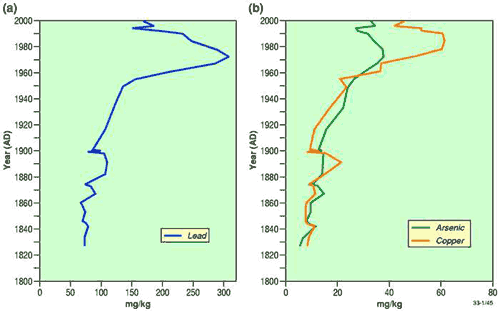What are metal contaminants?
Metal contaminants comprise metals and metalloids found in concentrations that exceed Australian and New Zealand Guidelines for Fresh and Marine Water Quality (ANZECC/ARMCANZ)1. The terms ‘heavy metals’, ‘toxic metals’, ‘trace metals’, ‘trace elements’ or ‘trace constituents’ are often used interchangeably in the literature, in reference to metals in aquatic systems. A recent definition of ‘heavy metals’ comprises the block of metals belonging to Groups 3 to 16 of the periodic table, in periods of 4 or greater2. However, there are many definitions for ‘heavy metals’ and none were derived from an authoritative body3.
Metals and metalloids occur naturally in the Earth’s crust, and are released to soils and the hydrologic cycle during physical and chemical weathering of igneous and metamorphic rocks. The background concentrations of these elements are mainly controlled by the geologic characteristics of the watershed. Some metals are naturally abundant and have high background concentrations (e.g. aluminium and iron)4. Other metals are rare and have low background concentrations (e.g. mercury, cadmium, silver and selenium)4. The rarer metals are referred to as ‘trace metals’, ‘trace elements’ and ‘trace constituents’. At low concentrations many of these metals are ‘micronutrients’ and as such are essential for life. However, many metals or metalloids can be toxic at high concentrations, hence the term ‘toxic metals’. There are also some metals with as yet no identified biological functions such as mercury and lead.
Sources of metal contamination
Human activities can increase metal concentrations to higher than background levels. Anthropogenic sources of metals include industrial and municipal waste products, urban and agricultural runoff, fine sediments eroded from catchments, atmospheric deposition, CCA treated wood walkways5, antifouling paints from ships (mainly tin and copper), metals from pipes in sewage treatment plants and drainage from acid sulfate soils and mine sites. Mine drainage, in particular, can significantly increase the concentrations of some metals. Metal contamination tends to be localised to areas situated in close proximity to mine sites, industrial installations and large cities6. In Australia, the latter are mainly coastal sites.
Metal partitioning – soluble and particulate phases
Metals are partitioned amongst soluble phases, suspended and bottom sediments and biota in aquatic systems4. The major pathways of metal partitioning include adsorption, complexation, precipitation and biological uptake4. Adsorption is usually the predominant process because metals have strong affinities for iron and manganese oxyhydroxides, particulate organic matter, and to a lesser extent clay minerals4. Consequently, metals tend to accumulate in bottom sediments. The soluble phase represents the principal source of bioavailable metals4. The dissolved fraction is favoured under conditions of low pH, low particulate loads and high concentrations of dissolved organic matter4. Low pH is particularly important because:
- the solubility of metal hydroxides increases as pH decreases;
- the adsorption capacity of solid surfaces decreases; and
- H+ ions compete with metals for coordination sites on organic molecules4.
More metals may also enter solution as water hardness increases, because cations (especially Ca2+ and Mg 2+) also compete with metals for binding sites4. However, increasing salinity usually results in reduced dissolved metal concentrations because clay-organic particles form flocs with a high settling velocity. High pH and Eh and elevated particulate organic matter concentrations favour metal partitioning to bottom sediments, or to suspended particulate phases if hydraulic energy is high enough4.

Figure 1. Metal partitioning in aquatic systems among 3 major phases (inside triangle) and some environmental conditions that favour each phase (outside triangle). (from Elder, J.F. 1988. Metal Biogeochemistry in Surface-Water Systems – A Review of Principles and Concepts. U.S. Geological Survey Circular 1013. Reproduced with permission of J.F. Elder).
Environmental significance
Metals tend to accumulate in animals and plants (including mangrove vegetation7 and seagrasses8 ). They enter aquatic organisms through body and respiratory surfaces, and by ingestion of particulate matter and water. Toxicity manifests as impairment of metabolic function, with possible changes to the distribution and abundance of populations4. Sublethal effects may include changes in morphology, physiology, biochemistry, behaviour and reproduction9. Massive fish kills can occur when aluminum and iron are mobilised with drainage from acid sulfate soils10. The extent of metal uptake, toxicity and bioaccumulation varies depending on the organism, and can be modified by temperature, pH, turbidity, dissolved oxygen and the concentrations of other metals in solution. Accumulation of metals by aquatic organisms (e.g. bivalves and crabs11 ) can be a useful indicator of the presence of metals in biologically available forms. If metal levels in organisms are too high for human consumption, shellfishing waters are closed.
Coastal habitats where metals accumulate
Metals have high affinities for fine-grained sediment. The concentrations of metals are therefore controlled to a large extent by processes governing sediment transport and deposition. In tide-dominated waterways (e.g. deltas, estuaries and tidal creeks), flanking environments are the main traps for fine sediments, and these include mangroves12, salt marshes 13 and intertidal flats1314. Fine sediments also accumulate in mangroves, saltmarsh and intertidal flats in wave-dominated coastal waterways (e.g. estuaries and strandplains), but the central basin is often the main sink. The baffling of water movement by seagrass leaves can also cause fine sediments and metals to deposit in seagrass meadows15. Chemical transformations and disturbances that threaten the integrity of these habitats (e.g. dredging16, reclamation and erosion) can remobilise metals from the sediments into the water column13.
Considerations for measurement and interpretation
Metals in soluble and particulate phases should be collected and analysed by standard methods (see Table 5.2 of the ANZECC/ARMCANZ Monitoring and Reporting Guidelines for Water Quality Monitoring and Reporting17 ). Studies of metal biogeochemistry should also include reliable pH measurements. Guideline trigger values for different metals and metalloids in water (µg L -1), sediments (mg kg-1 dry wt), and for the protection of aquaculture species (µg L -1) are listed Tables 3.4.1 (pg 3.4-5), 3.5.1 (pg 3.5-4) and Table 4.4.3 (pg 4.4-8) respectively of the ANZECC/ARMCANZ guidelines18. A decision tree is also provided in the ANZECC/ARMCANZ guidelines detailing steps in the assessment of contaminated sediment (see Figure 3.5.1, pg 3.5-6). A new approach being used at Sydney University involves not only an assessment of sediment quality, but also a determination of the severity of impact and the identification of contaminant sources and dispersion pathways (A Scheme for Assessing Human Impacts on Coastal Aquatic Environments Using Sediments).
Profiles of trace metals in dated sediment cores can be used to show changes in trace metal influx pre- and post-European arrival.

Figure 2. Lead, arsenic and copper concentrations measured in a 9 cm sediment core extracted from Lake Dora, a subalpine tarn located 15 km NE of Queenstown in western Tasmania. The chronology was determined on the basis of high resolution 210Pb analysis of the top 6 cm of the core. Increased trace metal values between 1880 and 1900 correspond with the introduction of smelters in the region. The significant increase in concentrations from 1960 correlates well with the international boom in copper prices and consequent increased production at Queenstown. The metals are thought to have been derived from open cut mining spoils and deposited in Lake Dora through wind transport (see Harle et al., 200219 ). Analyses were carried out at the Australian Nuclear Science and Technology Organisation as part of its Human Activity and Climate Variability Project. Contact Dr Kate Harle (Kate.Harle@csiro.au) for more information.
Existing information and data
Limited metal data for estuaries and coastal waterways are held by the collecting agencies (State, local Government, community groups and environmental consultants). Some qualitative data from state sources were compiled during the National Land and Water Resources Audit. This information is presented in summary form in the OzEstuaries database. Description of various metals and metalloids, and their toxicity to various organisms is discussed in detail in the ANZECC/ARMCANZ Guidelines17.
More information on Toxicants.
Contributors
Graeme Batley, Centre for Advanced Analytical Chemistry, CSIRO Energy Technology
Gavin Birch, Environmental Geology Group, School of Geosciences, The University of Sydney
J.F. Elder, USGS
Rob Fearon, CRC for Coastal Zone, Estuary and Waterway Management
Kate Harle, CSIRO
- ANZECC/ARMCANZ (October 2000) Australian Guidelines for Water Quality Monitoring and Reporting.
http://agriculture.gov.au/water/quality/nwqms#monitor ↩ - Hawkes, S.J. 1997. What is a “Heavy Metal”? J. Chem. Educ. 74, 1374. ↩
- Duffus, J.H. 2001. Chemistry International 23(6) (http://www.iupac.org/publications/ci/2001/november/heavymetals.html). ↩
- Elder, J.F. 1988. Metal Biogeochemistry in Surface-Water Systems – A Review of Principles and Concepts. U.S. Geological Survey Circular 1013. ↩ ↩ ↩ ↩ ↩ ↩ ↩ ↩ ↩ ↩ ↩
- Weis, J.S. and Weis, P. 2002. Contamination of saltmarsh sediments and biota by CCA treated wood walkways. Marine Pollution Bulletin 44, 504-510. ↩
- Cappo, M., Alongi, D.M., Williams, D, and N. Duke. 1995. A review and synthesis of Australian Fisheries Habitat Research: Major threats, issues and gaps in knowledge of coastal and marine fisheries habitats. Fisheries Research and Development Corporation (http://www.aims.gov.au/pages/research/afhr/afhr-00.html). ↩
- Melville, F. and Burchett, M. 2002. Genetic variation in Avicennia marina in three estuaries of Sydney (Australia) and implications for rehabilitation and management. Marine Pollution Bulletin 44, 469-479. ↩
- Prange, J.A. and Dennison, W.C. 2000. Physiological responses of five seagrass species to trace metals. Marine Pollution Bulletin 41(7-12), 327-336. ↩
- Connell, D.W., Miller, G.J. 1984. Chemistry and Ecotoxicology of Pollution. John Wiley & Sons, N.Y. ↩
- Sammut, J., White, I., and Melville, M.D. 1996. Acidifcation of an estuarine tributary in eastern Australia due to drainage of acid sulphate soils. Marine and Freshwater Research 47, 669-684. ↩
- Mortimer, M.R. 2000. Pesticide and trace metal concentrations in Queensland Estuarine Crabs. Marine Pollution Bulletin 41, 7-12. ↩
- Harbison, P. 1986. Mangrove Muds – A sink and a Source for Trace Metals. Marine Pollution Bulletin 17(6), 246-250. ↩
- Lee, S.V. and Cundy, A.B. 2001. Heavy metal contamination and mixing processes in sediments from the Humber Estuary, Eastern England. Estuarine and Coastal Shelf Science 53, 619-636. ↩ ↩ ↩
- Chenall, B.E., Yassini, I. amd Jones, B.G. 1992. Heavy metal concentrations in lagoonal saltmarsh species, Illawarra region, southeastern Australia. The Science of the Total Environment 125, 203-225. ↩
- Ward, T.J. 1989. The accumulation and effects of metals in seagrass habitats. In Larkum, A.W.D. McComb, A.J. and Shepherd, S.A. (Eds), Biology of seagrasses: A treatise on the biology of seagrasses with special reference to the Australian Region, pp. 797-807. ↩
- Carroll, S., O’Day, P.A., Esser, B., and Randall, S. 2002. Speciation and fate of trace metals in estuarine sediments under reduced and oxidised conditions, Seaplane Lagoon, Alameda Naval Air Station (USA). Geochem. Trans. 3(10), 81-101. ↩
- ANZECC/ARMCANZ (October 2000) Australian and New Zealand Guidelines for Fresh and Marine Water Quality. (www.ea.gov.au/water/quality/nwqms/#quality) ↩ ↩
- ANZECC/ARMCANZ (October 2000) Australian Guidelines for Water Quality Monitoring and Reporting.
- Harle, K.J., Britton, K., Heijnis, H., Zawadzki, A. and Jenkinson, A. 2002. Mud, mines and rainforest: a short history of human impact in western Tasmania, using pollen, trace metals and lead-210. Australian Journal of Botany 50, 481-497. ↩


